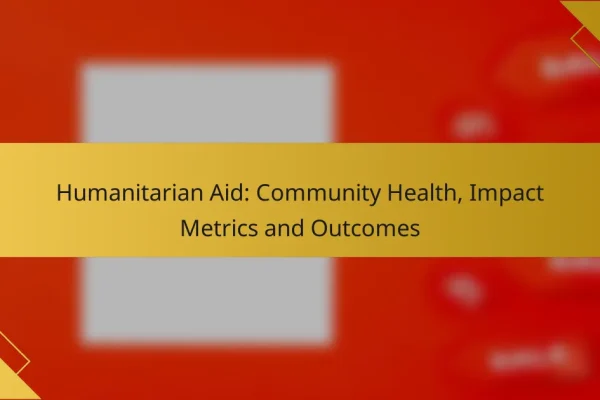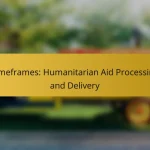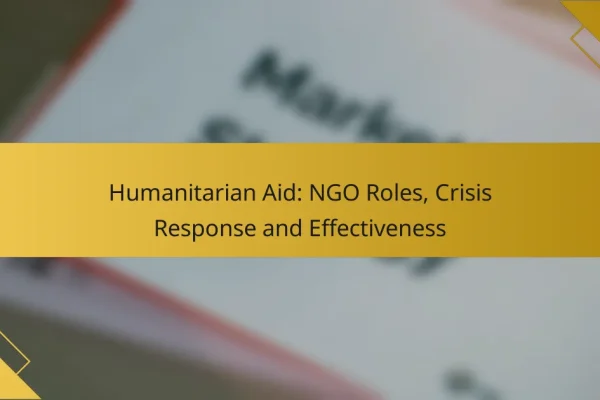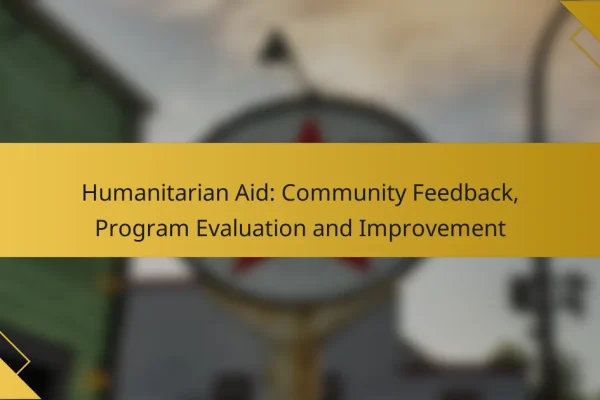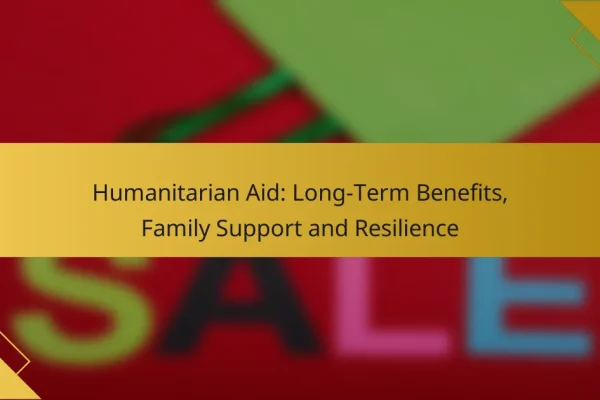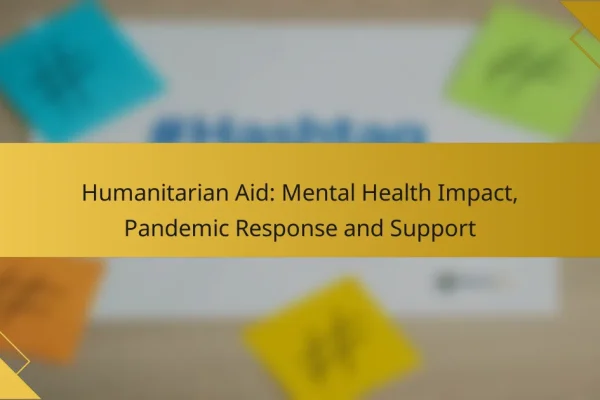How does humanitarian aid impact communities in Africa?
Humanitarian aid significantly impacts communities in Africa by addressing immediate needs and fostering long-term development. This assistance can improve living conditions, health, and economic stability, ultimately enhancing the overall quality of life.
Improves access to healthcare
Humanitarian aid enhances access to healthcare by providing essential medical supplies, personnel, and infrastructure. For instance, mobile clinics and vaccination campaigns can reach remote areas, ensuring that vulnerable populations receive necessary treatments.
Additionally, partnerships with local health organizations can strengthen healthcare systems, allowing for better training of healthcare workers and improved facilities. This investment can lead to a more resilient healthcare framework in the long run.
Enhances education opportunities
Humanitarian aid plays a crucial role in enhancing education opportunities by funding schools, providing learning materials, and training teachers. Initiatives such as building classrooms and supplying books can significantly increase enrollment rates, especially for girls.
Moreover, educational programs that focus on vocational training can equip young people with skills needed in the job market, promoting self-sufficiency and reducing poverty levels in the community.
Boosts local economies
Humanitarian aid boosts local economies by creating jobs and supporting small businesses. For example, cash transfer programs can empower families to invest in local markets, stimulating economic activity and fostering entrepreneurship.
Furthermore, aid projects that focus on agriculture can enhance food security and provide farmers with the tools and knowledge needed to increase productivity. This not only improves livelihoods but also contributes to the overall economic stability of the community.
What are the key types of humanitarian aid?
The key types of humanitarian aid include food assistance, medical aid, and emergency shelter. Each type addresses specific needs during crises, ensuring that affected populations receive essential support.
Food assistance
Food assistance provides essential nutrition to individuals and families affected by disasters or conflicts. This aid can come in various forms, including direct food distribution, cash transfers for purchasing food, or food vouchers.
Organizations often assess local food availability and dietary needs to tailor their assistance. For example, in regions facing famine, agencies might prioritize high-energy foods like fortified biscuits or ready-to-use therapeutic foods.
Medical aid
Medical aid focuses on delivering healthcare services and supplies to those in urgent need. This can include the provision of medicines, medical equipment, and trained personnel to treat injuries or prevent disease outbreaks.
In emergency situations, mobile clinics may be deployed to reach remote areas, ensuring that basic healthcare is accessible. It is crucial to consider local health regulations and the availability of medical facilities when planning such interventions.
Emergency shelter
Emergency shelter provides immediate housing solutions for people displaced by disasters or conflicts. This assistance can range from temporary tents to more durable structures, depending on the situation and available resources.
When implementing shelter solutions, organizations must consider factors such as climate, safety, and community needs. For instance, in areas prone to flooding, elevated structures or waterproof materials may be necessary to ensure safety and comfort for displaced individuals.
How effective is humanitarian aid in crisis situations?
Humanitarian aid is highly effective in crisis situations, providing immediate relief and support to affected populations. Its success often hinges on the speed of response and the ability to address both urgent needs and long-term recovery.
Rapid response capabilities
Rapid response capabilities are crucial for effective humanitarian aid, as they ensure that assistance reaches those in need quickly. Organizations often deploy teams within hours of a crisis, utilizing pre-positioned supplies and established networks to facilitate immediate action.
To enhance rapid response, agencies may conduct regular training and simulations, ensuring that personnel are prepared for various scenarios. Collaboration with local authorities and communities can also streamline efforts and improve outcomes.
Long-term recovery support
Long-term recovery support focuses on rebuilding communities and restoring livelihoods after the initial crisis has passed. This phase often includes providing education, healthcare, and economic opportunities to help individuals regain stability.
Effective long-term support typically involves partnerships with local organizations, ensuring that aid is culturally appropriate and sustainable. Monitoring and evaluation are essential to adapt strategies based on community feedback and changing needs, fostering resilience for future challenges.
What are the challenges faced in delivering humanitarian aid?
Delivering humanitarian aid is fraught with challenges that can significantly hinder its effectiveness. Key obstacles include logistical barriers, political instability, and funding shortages, each impacting the timely and efficient distribution of assistance.
Logistical barriers
Logistical barriers encompass the physical and operational difficulties in transporting aid to those in need. These can include damaged infrastructure, such as roads and bridges, especially in conflict zones or areas affected by natural disasters. Additionally, the lack of reliable transportation options can lead to delays in getting supplies to affected populations.
Organizations must also navigate customs regulations and import restrictions, which can vary widely by country. Understanding local regulations is crucial to avoid unnecessary holdups and ensure that aid reaches its destination promptly.
Political instability
Political instability can severely disrupt humanitarian efforts, as conflicts and governance issues often create unsafe environments for aid workers. In regions experiencing civil unrest or authoritarian regimes, access to affected populations may be restricted, complicating the delivery of essential services.
Moreover, political factors can influence the allocation of aid, with some governments prioritizing certain groups over others. Humanitarian organizations must remain neutral and impartial, but they often face challenges in maintaining this stance amid political pressures.
Funding shortages
Funding shortages pose a significant challenge for humanitarian aid organizations, limiting their ability to respond effectively to crises. Many organizations rely on donations from governments, private entities, and the public, which can fluctuate based on economic conditions and donor priorities.
To mitigate funding issues, organizations often need to diversify their funding sources and develop sustainable fundraising strategies. Establishing partnerships with local businesses or engaging in community fundraising can provide additional support, ensuring that aid efforts are not solely dependent on large donations.
How can individuals contribute to humanitarian aid efforts?
Individuals can significantly contribute to humanitarian aid efforts through financial donations and active participation in local initiatives. Both methods can create a meaningful impact in communities affected by crises.
Donations to reputable organizations
Making donations to established humanitarian organizations is a direct way to support relief efforts. Look for organizations with a proven track record, transparent financial practices, and positive reviews from beneficiaries.
Consider donating to organizations like the Red Cross, Doctors Without Borders, or local NGOs that focus on specific needs such as food security or medical assistance. Regular contributions, even small amounts, can accumulate and provide substantial support over time.
Volunteering in local initiatives
Volunteering for local humanitarian initiatives allows individuals to engage directly with their communities. This can involve helping at food banks, shelters, or community health clinics, where hands-on assistance is often needed.
Before volunteering, research local organizations to find opportunities that match your skills and availability. Many organizations welcome volunteers for short-term projects, making it easier to contribute without a long-term commitment.
What role do NGOs play in humanitarian aid?
Non-governmental organizations (NGOs) are crucial in delivering humanitarian aid, often acting as the primary implementers of relief efforts. They mobilize resources, coordinate with local communities, and provide essential services in crisis situations.
Types of NGOs involved in humanitarian aid
NGOs involved in humanitarian aid can be categorized into international, national, and local organizations. International NGOs often have a broader reach and more resources, while national and local NGOs may have better knowledge of the specific needs and cultural contexts of the communities they serve.
Examples of prominent international NGOs include the Red Cross, Médecins Sans Frontières, and Oxfam. Local NGOs might focus on specific regions or issues, such as food security or health care, and can be more agile in responding to immediate needs.
Funding sources for NGOs
NGOs typically rely on a mix of funding sources, including government grants, private donations, and corporate sponsorships. This diverse funding base allows them to maintain flexibility and adapt to changing circumstances in humanitarian crises.
Many NGOs also engage in fundraising campaigns and partnerships with other organizations to enhance their financial sustainability. Understanding these funding sources is essential for NGOs to effectively plan and implement their humanitarian programs.
Challenges faced by NGOs in humanitarian aid
NGOs often face numerous challenges in delivering humanitarian aid, including funding shortages, bureaucratic hurdles, and security risks in conflict zones. These obstacles can hinder their ability to respond quickly and effectively to crises.
Additionally, coordination among various NGOs and with governmental bodies can be complex, leading to potential overlaps or gaps in aid delivery. NGOs must navigate these challenges while ensuring they meet the needs of affected populations.
Measuring the impact of NGO-led humanitarian aid
Measuring the impact of humanitarian aid provided by NGOs involves assessing both quantitative and qualitative outcomes. Key performance indicators may include the number of beneficiaries served, improvements in health and nutrition, and the restoration of livelihoods.
NGOs often conduct evaluations and gather feedback from communities to understand the effectiveness of their programs. This data helps them refine their strategies and demonstrate accountability to donors and stakeholders.
